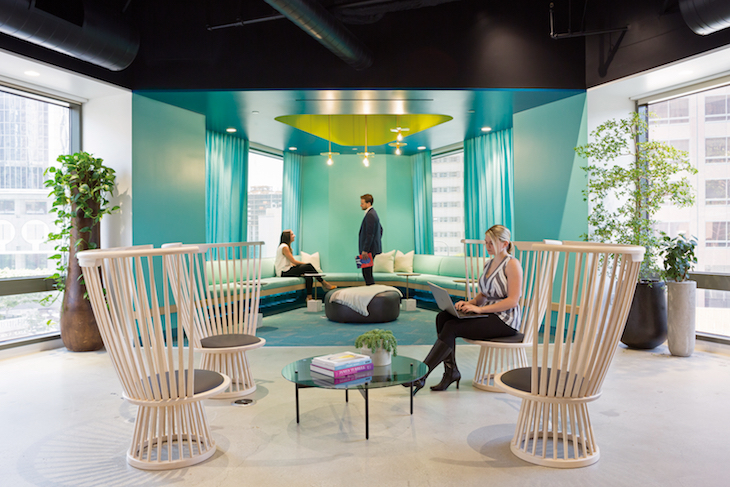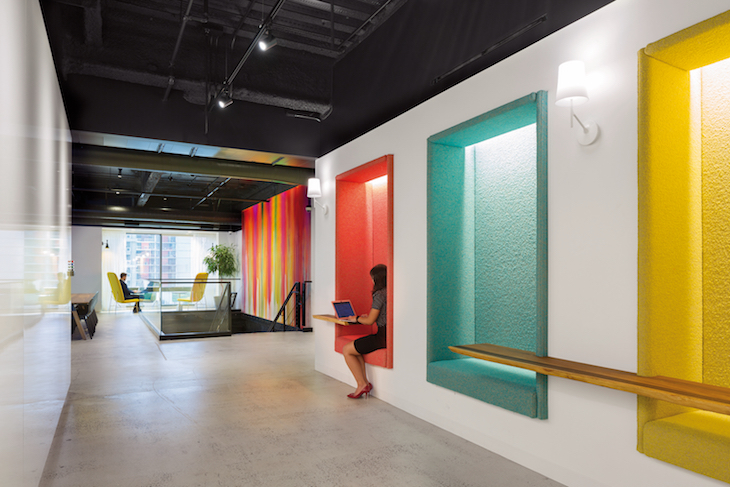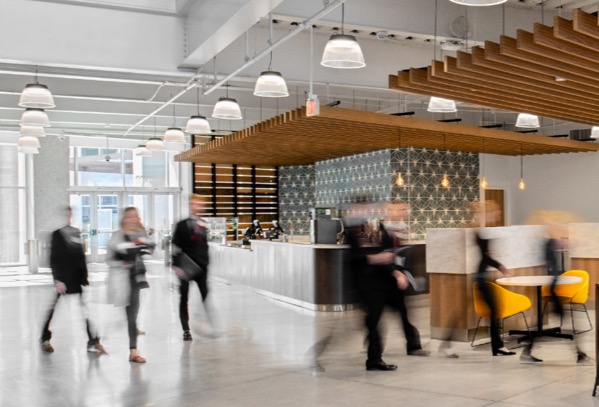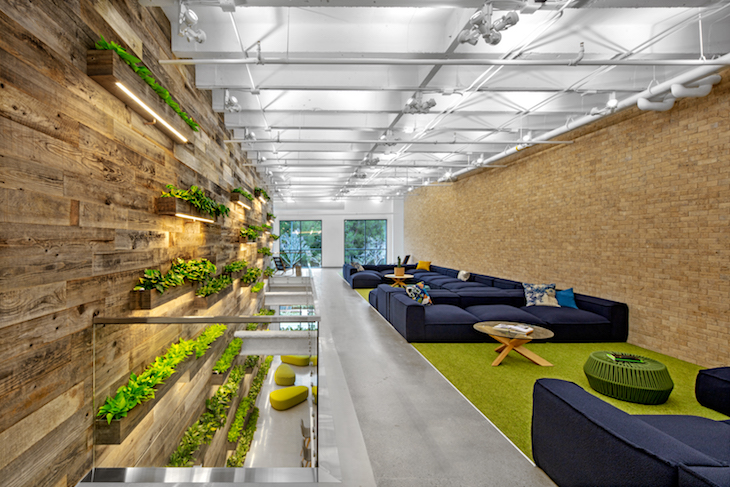“We need to ensure that our best asset, and the true currency of business – people – are in spaces where they can ALL thrive.”

We are living in a time of increased neurodiversity and awareness about ADHD, Dyslexia, Autism, and others neurological states. In fact, one in eight people are considered neurodiverse but fewer than 50 percent know it. Neurodivergents tend to be high energy, out of the box thinkers, excel in a crisis, and be bold problem solvers, but navigating the modern workplace can be a challenge. Not only is designing space to be inclusive the right thing to do, there is a compelling business case for it as well. Space today needs to reflect the diverse makeup of organizations to set all up for success.
As we share this information, there are a few key questions that continually come up.
Can you give us a deeper definition of the terms “neurodivergent”?
Neurodivergent conditions include Autism Spectrum Disorder (ASD), Attention Deficit Hyperactivity Disorder (ADHD) and Dyslexia. It has been reported that up to 17 percent of the population have been diagnosed with a neurodivergent condition:
- Four percent have ADD/ADHD;
- One percent have Autism;
- 10 percent have Dyslexia;
- One percent have Dyspraxia;
- One percent have Tourette Syndrome.
When you consider that many conditions go undiagnosed, 17 percent is therefore likely to be conservative at best. The World Health Organization noted that the prevalence of neurological conditions is one of the greatest threats to public health.
There are several gaps in understanding the many issues related to neurological disorders, but we already know enough about their nature and treatment to be able to shape effective policy responses to some of the most prevalent among them.
– World Health Organization [i]
Attention Deficit Disorder and Attention Deficit Hyperactivity Disorder
Attention Deficit Hyperactivity Disorder (ADHD) is a brain-based condition typically characterized by a persistent pattern of inattention and or hyperactivity and impulsivity due to under-stimulation of the brain. ADHD has three different subtypes; inattentive, hyperactive and combined and often coexists with one or more comorbid conditions such as Obsessive Compulsive Disorder (OCD), Anxiety, Depression, and Oppositional Defiance Disorder (ODD).
Jet Blue Airways founder David Neeleman is an ADHDer who espouses the benefits, “Just keep thinking about the positive side of ADD, the creativity and the originality that it stimulates.”
ADHDers can be particularly sensitive to sensory inputs, such as sounds, sights and smells. With a heightened sensitivity to smells, neurodivergents are often the first to detect or sense odors, hence they are the canaries in the coalmine. They can also experience challenges within social and work settings.
Autism Spectrum Disorder
Autism spectrum disorder (ASD) is a neurological disorder that affects how a person acts and interacts with others, communicates, and learns. It includes what used to be known as Asperger syndrome and pervasive developmental disorders.
Too often the neurodivergent are noted as under-performing. Feedback is often focused on what the individual needs to do in order to improve, instead of looking at environmental factors which could be limiting their ability to be successful.
– Helen Needham, Me.Decoded
There are some forward thinking high profile industry leaders such as Microsoft, Amazon, Ford, JPMorgan Chase, EY, DXC Technology, Costco, and Google who are all investing neurodiversity-at-work programs. Enterprise software firm SAP has gone one step further, committing to a goal to have one percent of its workforce made up of those on the autistic spectrum by 2020 – reflecting the percentage of the global population that is autistic.[ii]
Dyspraxia, Dyslexia and Dyscalculia
Dyspraxia is sometimes referred to as (DCD) Developmental Co-ordination Disorder which is a complex neurological condition involving multiple brain functions which govern the co-ordination of muscles and perception and may also affect language and thought.
Those who have Dyspraxia often find their strengths include increased creativity and innovative thinking with an ability to strategically apply these traits to solving complex problems within the workplace environment. Entrepreneurs are very often dyslexic, including Richard Branson, who once noted in an interview with the Independent “my dyslexia became my massive advantage: it helped me to think creatively and laterally, and see solutions where others saw problems”.[iii]
Tourette Syndrome
Tourette Syndrome (TS) is a complex neurological condition which is genetically inherited. There are some common involuntary and uncontrollable manifestations of TS such as; tics which can be physical from minor movements to more major body motions and verbal expressions which can include laughing, talking and coughing.
Parkinson’s Disease Dementia
Parkinson’s is the fastest growing neurological disorder globally. Parkinson’s disease is a progressive neurological disorder that targets dopamine and the brain cells that control movement. The disease usually strikes adults over age 50, although it has been diagnosed as early as age 20. Due to its slow progression, most individuals have several productive years of living after being diagnosed. Hence the disease largely has adverse effects on those over 60. But as the retirement age rises and the workforce ages this could increasing become an issue we need to address in the workplace.
Comorbidity
The coexistence of multiple conditions, comorbidity, effects a large segment of the neurodivergent population. For example, two-thirds of people with ADD/ADHD have at least one other condition: Anxiety [34 percent] Depression [29 percent], Bipolar Disorder [12 percent], Substance Abuse [5-40 percent], Tourette Disorder [11 percent], Obsessive Compulsive Disorder [4 percent], Oppositional Defiant Disorder [54-67 percent], Conduct Disorder [22-43 percent], etc.

Does this relate to mental health?
It’s essential that we also consider the consequence of the rising prevalence of mental health conditions in our design process, depression and anxiety, though not neurological disorders, are major mental health challenges we face today in the workplace. One in four people are likely to have a mental health challenge at some point in their life. Stress is often the most common and can be caused by a combination of work, home, and personal factors. Ironically, despite prevailing stigma, people are more open to talking about mental health than neurodiversity.
Increased awareness of neurodiversity has led to better diagnoses – prevalence rates have consistently been masked by misdiagnosis of mental health issues and this continues to be so though less than 20 years ago.
– Dr. Nancy Doyle, CEO, Genius Within
There is growing research to suggest that some neurological conditions such as ASD will cause the individual to have a stronger predisposition, when compared to neurotypicals, to suffer from anxiety and depression. It is for this reason that whilst neurodiversity and mental health are different things they should be thought about together on a contextual basis.
Despite the impact it has, the global spend on mental health is less than $2 USD per person.[iv] Treatments for depression and anxiety is vastly underutilized. In high-income countries with well-established healthcare systems, 35–50 percent of people living with mental illness receive no treatment. In low to middle-income countries, upwards of 76–85 percent of people living with mental illness do not receive treatment.[v].
Statistically speaking:
- It is estimated that depression and anxiety cost the global economy $1 trillion USD due to lost productivity[vi]
- When left unmanaged, depression can result in suicidal thoughts, attempted, and completed suicide. More than 800,000 deaths per year worldwide are attributed to suicide, all of which are preventable. Young adults and adolescents are particularly at risk and suicide is now the second leading cause of death among youth between the ages of 15–29 years old.[vii]
- We have the highest rate of teen depression in history
- 60 percent to 80 percent of workplace accidents are attributed to stress[viii]
- Adverse effect of social media, screen addiction and Facebook Depression Syndrome are on the rise, and neurodivergents are more prone to be afflicted.
- Over 30 percent of adults will experience a mental health condition during their lifetime.
What are some the challenges neurodivergents face in the workplace?
Distractions. It’s getting harder to focus, to concentrative, and to think at work. More than two-thirds of people have said that acoustical distractions are their number one concern when working in a space. Intermittent unpredictable noise, is particularly stressful.[1] Distractions are leading to a loss of productivity. But often the real issue today is not that the office is too loud, but rather that it is too quiet. With quieter keyboards, more texting, and fewer people communicating via phone, there is no background noise, or ‘hum’ that muffles general office sounds. The real problem is when you are in an environment where you can hear what people across the room are saying clear as a bell. That is far more distracting then general background noise.
And it’s not just noise. Our technology is a major point of distractions today as well. The consistent “pinging” of our phones, IM, or other communications tools are often more of a distraction than even the people and noise of the environments we are sitting in.
To mitigate distractions, we need to design spaces with options and empower people to find the right solution that meets their specific needs. That should include areas for focus, areas for concentration, and the creation of tech-free zones where we can escape the impact of constantly being pinged by technology.
Sensory Stimulation. For people with developmental disabilities, sensory cues can be overwhelming. Having a space where you can control sensory stimulation is important. Just as a person with different physical challenges requires unique solutions tailored to their needs, so is the case with neurodivergents. Solutions that may work on certain neuroprofiles may not work on others. For some it’s a lack of stimulation while others are easily overwhelmed by it.
Wayfinding. Many people with neurodivergent conditions need and thrive on repetition, predictability, and clear boundaries to feel ‘safe’ and in ‘control’. Environments needs to make sense… thus effective wayfinding is key. But overly redundant spaces lack inspiration. Having a space where there is more to it than meets the eye can make people feel more engaged and eager to move through the space while still keeping it easy to navigate.
Places with clear lines of sight and viewpoints, such as internal staircases or mezzanines, help orient us in a space. Designing spaces with intuitive wayfinding elements can assist our brains’ innate positioning systems. Be it various lighting levels, signage, art, or the strategic use of color that act as memorable landmarks, creating spaces that are memorable with a varied landscape can also aid with orientation.
How can we design spaces to be more inclusive?
How we design space can have a profound impact on the people who occupy and experience it. Recent studies[ix] have emphasized that employees tend to be more productive and satisfied when they have a variety of workspace types to choose from, depending on the type of task they are engaged in. Space can help remove barriers; it can improve culture and attitudes; it can help remove stigmas and it can increased choice enabling people to be successful.
Design professionals use a common language and toolkit to address design challenges. The principles of design outline the guidelines for the creation of successful spaces.

Emphasis | Balance | Rhythm | Proportion | Unity (Harmony and Variety)
The elements of design are the tools used to execute on the principles and design concepts. While designing for inclusion, there are some key principles and elements to consider.
Light | Form | Line | Color | Texture | Mass | Space | Pattern
Emphasis – Creating focal points within the space – be it an architectural element or graphics – can aid in wayfinding and mapping of the space making them easier to navigate.
Rhythm – Designing the space with common elements, either from floor-to-floor or within one’s view point, can aid in orientation and provide a reassuring sense of order within an environment.
Proportion – Proportion ensures the relative size and scale of the various elements in a design. If the proportions are off a space can feel unbalanced or not in sync with human scale. Ceiling heights and room proportion are critical to ensure the feel of the space is appropriate.
Balance – Balance creates visual equilibrium and often reconciles opposing forces in a composition to create visual stability. Most successful compositions achieve balance by either symmetry or asymmetry.
Light – Research by University of Toronto suggests that bright light can intensify our feelings, both positive and negative. Turning down the lights can help us make more rational decisions. When interior lighting conditions are changed during the day to mimic the changes in light color and intensity experienced outside, the functioning of the circadian system is more likely to align with user’s location on the planet, which reduces experienced stress levels. [x]
Color – Color is a powerful communication tool and can influence mood and impact performance. But exposure to color can also have a physical impact on us. Certain colors have been associated with increased blood pressure, increased metabolism, and eyestrain. Color can have symbolic meaning in various cultures, but the way color impacts us tends to be universal.
- Blue – is seen as the color of authority; it is a nature appetite suppressant; it can calm us down and help with analytical thinking. But if there is too much of it without the relief of white it can make people feel “blue”, sad, or depressed.
- Yellow – encourages positive thinking, heals the nervous system, relieves depression, and helps to treat unresolved feelings. It can be seen as a warning color. It makes us feel energized, warm, and is good for creative thinking.
- Red – is a warming color and, as a stimulator, increases the heart rate, brain wave activity, and respiration. It is energizing and encourages confidence and courage. It increases our appetite, our circulation, and can make us feel more aggressive or agitated if in our view for too long.
- Green – reminds us of nature and make us feel more relaxed. Green is very calming, relieves stress and creates a tranquil environment.
- Orange – can be mentally stimulating but is also seen as a social-economic neutralizer. Orange is used to alleviate fatigue, treat depression, helps to assimilate new ideas, and removes repression and inhibitions. It increases IQ when used in classrooms. It can make us feel enthusiastic and increase our energy levels if not overdone.
- Pink and lavender – can be very soothing. Pink has a tranquilizing effect on aggressive behavior and is used to treat anxiety and withdrawal symptoms. They can also be emasculating and reduce aggression.
- Violet – creates a peaceful environment and is used to treat insomnia & compulsive behavior.
- Brown – is seen as a neutral color but can give us a sense of reliability and strength. Brown is associated with resilience, dependability, security, and safety. It too reminds us of nature and can make us feel more genuine and relaxed.
Pattern – Patterns in nature tend to be organic, irregular, and exhibit a level of complexity. But in nature there are also geometric patterns. Our need for predictability and repetition has led to embracing symmetries and self-referring geometric systems, known as fractals structures. These predictable patterns help us understand, manage and navigate our world. Pattern recognition and logic order often results in acceptance and pleasure.
High Tech = High Touch
In today’s high-tech environment, our minds and bodies are tracking an exceedingly wide array of stimuli. But these high-tech spaces can leave us feeling overwhelmed and, at that same time, can make us feel we are missing out on something.
To balance the high-tech world we are living in, we can introduce natural elements to the built environment. Natural materials evoke a feeling of nature and are calming, refreshing, and relaxing. Wood gives us a connection to nature and a sense of authenticity, an organic feel, and is symbolically sustainable. Incorporating biophilia and natural materials into our environment helps to mitigate the negative impact of stress and have positive impacts on the wellbeing of occupants. Plants can also help offset smells and odors. Biophilia including a variety of natural elements – water, views, natural landscaping concepts and organic forms, natural daylight, etc.

Today we go beyond simply applying nature to walls, we are designing with nature as a core inspiration. We integrate and layer natural elements into the built environment to mitigate stress, engender positive psychophysiological responses, and contribute to the health, wellbeing and happiness of occupants.
What are the first steps we should take to provide spaces that are inclusive?
A workplace assessment but can provide employers and their HR and CRE teams with helpful information regarding planning and design elements that can help create a more inclusive work environment. Adjustments are frequently easy to make and aren’t costly. Employers surveyed by the US Job Accommodation Network found that as many as 95 percent of adjustments cost nothing for the employer to implement. Organizations need to think about programs to bring awareness, educate, and sensitize neurotypicals on working with neurodivergents and engaging them. Training around how to adjust to or ignore certain inherent behaviors is also highly beneficial. Designing for neurodiversity and inclusion not only can unleash new opportunities and be good business, but it is a social and moral imperative.
By designing the space to accommodate a variety of work styles, personality types, and abilities we can create spaces where everyone can find setting that meets their needs to successfully achieve the task at hand. If we focus more on environmental factors and the impact they have on people we can create the type of spaces that people want to experience, are inclusive, and help us all be more successful in our life pursuits. We need to ensure that our best asset, and the true currency of business – people – are in spaces where they can ALL thrive.
ENDNOTES
[i] World Health Organization – Neurological Disorders: Public Health Challenges
[ii] People Management -Why employers should be hiring with neurodiversity in mind; SAP’s Autism at Work Program Provides Meaningful Employment for People on the Autism Spectrum
[iii] Independent – Dyslexia should be recognised as a sign of potential, says Richard Branson
[iv], [v], [vi] WELL Certified – Mental Health Promotion
[vii] PRB – Suicide Replaces Homicide as Second-Leading Cause of Death Among U.S. Teenagers
[viii] American Institute of Stress – Workplace Stress
[ix] ASID – Impact of Interior Design on Human Experience: A Review of Research Revised, Updated and Expanded – 2018


Great insights shared! Workspaces that enhance productivity and comfort for some will have the opposite effect on others. Neurodiversity will help greatly in ensuring more comfort, productivity and wellbeing in the workplace.
Do you have any references or scientific evidence to back up your point about colours and how each colour affects people?
Colour affects us all different so I find it weird that you would call out how each colour affects people in the same way.